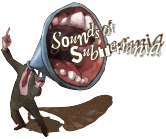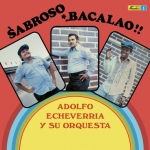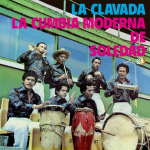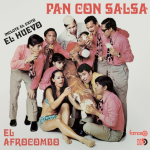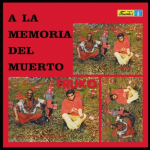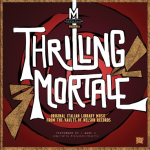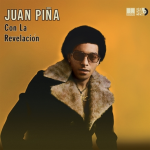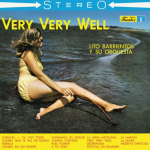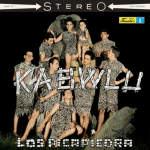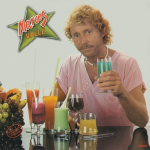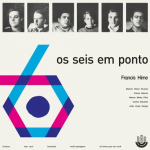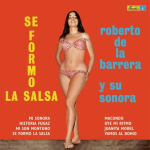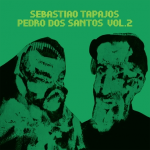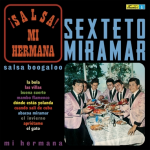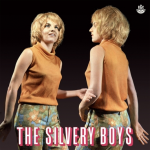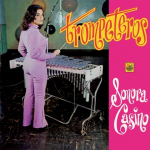Labels
Vampisoul
- 01. Noches de cumbia
02. Locura es mi cumbelé
03. Amor zalamero
04. Perdóname
05. No puedo vivir sin ti
06. Sabroso bacalao
07. Fantasía marina
08. Pobrecito mi corazón
09. Mi viejo barrio
10. Llorando por tiADOLFO ECHEVERRÍA Y SU ORQUESTA
Sabroso bacalao
[engl] Born on September 3, 1934 in the barrio of San Roque in Barranquilla, Adolfo Ernesto Echeverría Comas started singing on the radio first as a young man, forming his own conjunto and signing with various labels over the years, becoming one of Colombia’s premier band leaders, composers, interpreters and producers of tropical costeño music in the process. Among many other accolades, he is a winner of five Congo de Oro and one El Cacique de Oro awards; his holiday songs ‘Las cuatro fiestas’ and ‘La Inmaculada’ are recognized as national treasures. During his long and successful career, he has toured Venezuela, Panamá and Ecuador, and while performing in the United States was befriended by Celia Cruz and Tito Puente. Recognizing his songwriting talents, the pair asked him for a tune and he gave them ‘Salsa de tomate’, inspired by Tito’s hatred of the term, which they recorded for their “Alma con alma” release on Tico Records in 1971.By 1976, Adolfo Echeverría had signed with Discos Fuentes, where he was to remain until 1990 when he suffered a heart attack and was sadly never able to resume his career. Echeverría’s first year with the label was a great success, with his eponymous debut LP containing his biggest hit, the self-penned cumbia party anthem ‘Amaneciendo’. The following year, working again with the Fuentes hit production team of Isaac Villanueva and Hernán Colorado, Echeverría came out with “Sabroso bacalao”, sharing the vocals with Freddy Cruz and Manuel Cassiani. As with the first album, in addition to some hot, driving hardcore salsa tracks like ‘Mi viejo barrio’ and ‘Perdóname’, Echeverría made sure to include his beloved tasty indigenous cumbia and porro. In addition, the cut ‘Llorando por ti’ is in the Afro-Cuban oriza rhythm style, while ‘Locura es mi cumbelé’ is described as a ‘cumbelé’ (inspired by The New Swing Sextet’s 1970 song ‘Cum Cumbele’, which is a variant on the bomba, an Afro-Puerto Rican folkloric drum-based genre). Throughout this diverse genre-hopping album one can always hear the forcefully fiery piano of Hugo Molinares, who also composed the monster guaguancó track ‘Sabroso bacalao’. At the time, the LP yielded the domestic hit ‘Fantasía marina’ but in recent years ‘Noches de cumbia’ and the title track have become international tropical DJ dance floor standards across the globe, making this record a must-have for collectors, disk jockeys and aficionados of the classic Fuentes sound.- Format
- LP
- Release-Datum
- 15.11.2019
- EAN
- EAN 8435008863494
- 01. La clavada
02. Indio Faroto
03. El Currambero
04. Puñi molío
05. Cumbia Soledeña
06. Crees que soy sexy
07. Llegó el gorrero
08. Busca perro
09. El escándalo
10. La tembladeraCUMBIA MODERNA DE LA CLAVADA
La clavada
[engl] Contrary to popular belief, so-called ‘folkloric’ music is not always conservative and static, and is often the cultural space where musical innovation and experimentation first take place. Additionally, since folk music is often produced “by the people for the people”, it is frequently quite popular and dynamic; indeed it is seen as an integral part of a people’s identity, and yet often keeps its humble and unadorned trappings from whence it came, even when commercial interests try to harness, modify, water it down and sell it elsewhere. Though it may not be fashioned for the mass pop youth market, folkloric music has not only influenced more mainstream popular styles, it has often cross-pollinated and reacted to the larger more hegemonic mainstream music surrounding it in creative and innovative ways that bely the musicians’ seemingly simple, ‘homespun’ or humble origins or modes of expression.Such is the case with the octogenarian musician, composer, vocalist and teacher Pedro Beltrán aka “Ramayá” who hails from Patico, a small town in Colombia’s Bolívar province, not far from the Caribbean coast. He has been crowned Rei Momo of the carnival in Barranquilla, and recorded many albums as a leader and sideman, working with various domestic and international pop artists as well, from Quantic and Thornado to Systema Solar. While his main instrument is the ‘caña e millo’ flute, he is also proficient in the various percussion instruments of his region as well as the reed instrument known as the ‘gaita’. His group La Cumbia Moderna de Soledad (named for the large city within the municipality of Barranquilla) was founded in the early 1970s when Ramayá had already retired from a career in the army and was living in Soledad. With this group he set out to “modernize” the folkloric music of his people, adding the electric bass and a brass section to fresh arrangements of cumbias, porros, fandangos, puyas and other costeño genres. What’s more, the band often did left-field cover versions of international dance hits that were popular in the region’s sound systems (picós) and discotheques, from Fela Ransome-Kuti And The Africa ‘70’s ‘Shakara Oloje’ to Rod Stewart’s ‘Da Ya Think I’m Sexy’. If you think this sounds like a case of post-colonial cargo-cult worship or a record label marketing gimmick, think again, because there is something fantastically otherworldly yet “right” about this cross-cultural mash-up, especially since La Cumbia Moderna de Soledad proudly maintained its authentic Afro-Colombian and indigenous roots throughout, making for an infectious mix that was very popular at the time (especially in the Carnaval de Barranquilla) and is still danced to today by Colombians and other fans all over the world. In a way it’s as if these musicians, brought up in the ancient rural traditions of their culture, were trying to make musical sense of the rapidly changing and mechanizing urban environment around them.“La Clavada” (1979) was La Cumbia Moderna de Soledad’s sixth record and first for Codiscos’ Costeño imprint. The LP has many excellent examples of Pedro “Ramayá” Beltrán’s innovative, catchy and downright playful mix of the ancient and the modern, making for a collection of tunes brimming with tradition and yet fearlessly bristling with innovation, not the least of which is “Crees que soy sexy” with its crazy yet very catchy “English” lyrics and haunting gaita refrain mimicking the main melody of Rod Stewart’s previously mentioned international disco smash. In addition, the title song was a massive hit in Colombia and has been covered as a merengue by Dominican artist Cuco Valoy & Los Virtuosos, and ‘Cumbia Soledeña’ became an imported discotheque hit in Europe and England as well. Now, faithfully restored to its original glorious sound, this album is poised to be rediscovered as an innovative yet rootsy gem that deserves a second life within today’s vinyl revival and continued interest in Colombia’s musical past.- Format
- LP
- Release-Datum
- 15.11.2019
- EAN
- EAN 8435008863517
- 01. El huevo
02. Barranquilla, Sol y cumbia
03. Mira muñeco
04. Oye cómo va
05. A la Fiesta del Mar
06. Bomba pa' los cueros
07. La bailadora
08. Tus lindos ojos
09. Pan con salsaEL AFROCOMBO
Pan con salsa
[engl] Although Pete Vicentini’s El Afrocombo did not have the overwhelming commercial and international success of Fruko y sus Tesos, Joe Arroyo y La Verdad or Grupo Niche during the height of Colombian salsa in the 1970s and 80s, Pedro “Pete” Luis Vicentini del Valle (born in 1946) and his combo did have a popular following among fans in the Atlantic and Caribbean coastal areas of Colombia (especially in his home town of Barranquilla) and consequently, Vicentini has won the respect and admiration of many salsa aficionados for his long career of excellent performances and recordings, plus his professionalism and artistic quality as musical director, composer, bassist, pianist and arranger. In addition to founding what would become El Afrocombo, Vicentini was associated for several decades with the popular singer Jackie Carazo and was a member of Carazo’s El Clan Antillano as well as Chico Cervantes y su Sonora Caliente.“Pan Con Salsa” is Vicentini and El Afrocombo’s first long play and was released in 1971. As the title (and humorous cover) suggest, the majority of selections on the record are in the salsa genre that was gaining steam at the time in South America. In reality, though, the album includes Vicentini’s native costeño rhythms like cumbia and porro as well (on the tunes ‘Barranquilla, sol y cumbia’ and ‘Tus lindos ojos’). The LP has its own lively ‘combo’ sound in the plucky brass section (two trumpets and two saxes), plus the always bright and happy piano stylings of Willy Newball and of course the prominent bass playing, expert direction and arrangements of Vicentini. Additionally, the record contains the band’s first hit, ‘El huevo’, which is a cover version of Peruvian vocalist Félix Martínez’s popular 1971 tune in the guajira genre with Lima’s Los Girasoles, ‘Ese huevo se pasó’. In addition, there are some super hot original salsa tunes like ‘Mira muñeco’ and ‘La fiesta del mar’, a funky boogaloo cover of Tito Puente’s ubiquitous ‘Oye cómo va’ (with a cool clavinet solo), a Puerto Rican style bomba written by Carazo, and the title track, composed by Vicentini, which is a frenetic descarga (jam session) with lots of tasty brass solos, in-the-pocket piano tumbaos (riffs) and break-neck percussion work-outs. This album is definitely a persuasive argument for including the unjustly obscure El Afrocombo in the pantheon of hot Antillean-inspired bands from Barranquilla and proof that Colombia’s Caribbean coastal region was instrumental in pioneering the popularity of domestically produced salsa there in the 1970s, helping it spread into the interior and from there internationally by the 80s and 90s.- Format
- LP
- Release-Datum
- 15.11.2019
- EAN
- EAN 8435008863500
- 01. A la memoria del muerto
02. Mi verdadero son
03. Payaso
04. Los Niches
05. La fruta bomba
06. Achilipú
07. A bailar oriza
08. Descarga Fruko
09. Bomba africana
10. Baho Kende
11. Rumbo a la ciudad
12. TihuanacoFRUKO Y SUS TESOS
A la memoria del muerto
[engl] "A la memoria del muerto" is Fruko y sus Tesos' second album, released in 1972, and features exclusively the soaring and soulful vocals of Cali native Edulfamid Molina Díaz, aka "Píper Pimienta", Fruko's previous vocalist Humberto "Huango" González having left after the first album "Tesura". The record is a mix of spirited cover versions and authentically Nuyorican-sounding originals with a Colombian twist, while the cover art, enhanced by an abundance of blood-red design, is quite something, featuring Píper Pimienta and Fruko dressed as gun-toting hippies doing drugs in a cemetery while a transistor radio plays. Just as eye-opening as the music is celebratory! According to Fruko, the Woodstock generation was finally making itself felt in Colombia, and they were embodying the name of the album literally, ostensibly pointing out the dangers of said drug-thug lifestyle in no uncertain terms (the police threw them out during the shoot thinking they were authentic gangsters).Produced and engineered by Fruko's uncle Mario "Pachanga" Rincón, the album has an uncompromisingly stark, hard sound that is appealing to today's collectors of 'salsa brava' just as it was impactful on the Colombian scene when it was made at the beginning of the 1970s (very little of this type of music was produced in Colombia at the time). Unlike the first Tesos album, with a two trumpet line-up and fairly simple arrangements, this more mature recording added another trumpet and two trombones for a more robust brass attack. Additionally, instead of basic salsa, there are many different rhythms – guaguancó, bomba, plena, oriza, bolero, cha-cha-chá, descarga and Latin soul. Though Fruko's sound at this stage wore its New York, Havana and San Juan sources on its sleeve – Willie Colón, Javier Vázquez, Richie Ray to mention a few progenitors –, at the same time the album has a uniquely Colombian approach to these influences with the bounciness of coastal music like cumbia being felt throughout.The title song is a 'guaguan-plena' version of Dominica y su Conjunto's original 'acuyuye' (ie pachanga) hit of the same name from a decade earlier. Following that is Fruko's take on Cuban pianist Javier Vazquez's driving salsa dura anthem 'Mi verdadero son'. For a little variety, next up is a rendition of Puerto Rican pianist Raphy Leavitt's famous lovelorn bolero-cha 'Payaso' from 1971. Píper Pimienta brings the energy up again with Fruko's own bomba 'Los niches' – a party tune with an Afro-Colombian theme. The side finishes out with more cover versions: the double-entendre 'La fruta bomba' by Cuban trovador Maximiliano "Bimbi" Sánchez y su Trío Oriental and the fiery rumba gitana 'Achilipu' – first recorded by Barcelona's Gypsy Queen, Dolores Vargas, and subsequently made into a salsa groover by Puerto Rico's El Gran Combo in 1971. Side B kicks off with one of Fruko's favorite Afro-Cuban artists, the conguero and Santería singer Silvestre Méndez, with 'A bailar oriza' (made famous by Cortijo y su Combo in the 1950s). After a wild descarga (jam session) track, we are treated to a fun pair of cover tunes: Johnny Zamot's 'Bomba africana' (more triangle!) and the old Afro-centric chestnut by folkloric Cuban rumbero Alberto Zayas, 'Baho Kende' – a hit for Celia Cruz and La Sonora Matancera in the 1950s but done here in the early Willie Colón style. The record finishes off with another Fruko original written with his Discos Fuentes colleague Isaac Villanueva. The lyrics are from the point of view of the poor country peasant leaving the mountains and escaping the slavery of rural poverty for what he thinks will be the promise of opportunity dubiously offered by "The Big City".- Format
- LP
- Release-Datum
- 31.03.2017
- EAN
- EAN 8435008863159
- 01. Intro
02. Bongos Suspence
03. Smookie
04. Asfalto In Agguato
05. Ossessione Omicida
06. Base Pericolosa
07. Suspence Subacqueo
08. Corsa Pericolosa
09. Immagini
10. Thrilling Mortale
11. Temporale
12. Boxes
13. Drumming Free
14. Tensione Ed Attesa
15. Tema Di Raven I Vers
17. Atmosfere Spaziali
18. GialloI MARC 4
Thrilling Mortale
[engl] Welcome to the third instalment in our series dedicated to the original Italian library music from the vaults of Nelson Records. In this album we dig deeper into the most experimental recordings in the archives of Nelson Records.The label was founded in 1970 by the musicians Maurizio Majorana, Antonello Vannucchi and Roberto Podio (who along with Carlo Pes would be known as I MARC 4), after establishing the Telecinesound studio, right where the New Italian Library Sound was created. They recorded with Armando Trovajoli, Piero Piccioni, Ennio Morricone, Piero Umiliani, Henry Mancini and many others, and created a special sound, mixing jazz, pop, rock and psychedelic music, to produce records aiming to be used by the programmers of the Italian RAI television.The music of “Thrilling Mortale” is mostly special effects, drum breaks, fast bongo rhythms and groovy Hammond background sounds inspired by cinema noise experts who did not use any musical instruments and had only a few objects to recreate the noises of the films; from horse rides to closing gates, everything was done in the traditional way. I MARC 4, instead, would recreate those sounds with bass, guitar, drums, piano and Hammond organ.Many musicians, record producers and film directors still like, look for, rediscover and re-use for their work, and the music on these albums recorded by I MARC 4 between 1970-1976 have reached cult status among library music collectors.- Format
- LP
- Release-Datum
- 13.12.2019
- EAN
- EAN 8435008863388
- 01. Pájaro Maluco
02. Virgenes del Sol
03. Me dejaste
04. Negro con salsa
05. Hogar campesino
06. Cumbia y porro
07. Chana
08. Juan Manuel
09. Parecito Faraón
10. De Colombia pa´Venezuela
11. Mi plegariaJUAN PIÑA CON LA REVELACIÓN
s/t
[engl] At the age of 24, Juan Piña formed the eight-piece La Revelación with his brother Carlos, releasing their first album in 1975 on Discos Zeida. This self-titled debut LP of Piña with his group is something of an anomaly in his discography as subsequent albums would feature a different sound and concentrated almost exclusively on Colombian coastal Caribbean and ‘sabanero’ genres.Although Juan Piña’s debut record never made much of a splash, it is an excellent little slice of Colombian mid-70’s madness, with a very diverse sound. An interesting and joyful sounding mix of New York style salsa, Cuban son montuno and guajira with Colombian tropical flavors, the simple, spare arrangements featured electric guitar, piano, Latin percussion, two trumpets, occasional sax, and Juan sang lead while Carlos backed him on chorus. It also sounds like Joe Arroyo may have done ‘coro’ chores on Juan Piña Con La Revelación (Arroyo was a very close friend of Juan and sang chorus on several Revelación albums).This album is hard to find in the original edition, but collectors in the know treasure it for its two hot salsa tunes (‘Negro con salsa’ and ‘Chana’, both written by famous Chocoano composer and vocalist Alfonso Córdoba “El Brujo”) as well as producer Rafael Mejia’s salsa guajira ‘Hogar campesino’ and the genius rendition of the Peruvian classic ‘Virgines del sol’.A beautiful and mature sounding work for the relatively young Juan Piña and his crew, and well-worth rediscovery by today’s Colombian music enthusiasts.- Format
- LP
- Release-Datum
- 28.08.2020
- EAN
- EAN 8435008863715
- 01. Caracol
02. Ya voy, Toño
03. Cumbia que te vas de ronda
04. Rubiela
05. Cumbia en Do menor
06. Charanga pa gozar
07. Cumbia costeña
08. Kijis Konar
09. Mosaico: A tu vera / La india motilona / Very Very Well / Despeinada / Festival en guararé / La mafafa / La sampa / Negrito tapetuzaLITO BARRIENTOS Y SU ORQUESTA
Very Very Well
[engl] Colombia spawned several big band tropical orchestras in the 1930s and 40s, perhaps the most famous being those of Lucho Bermúdez, Pacho Galán, Edmudo Arias, Pedro Laza and Crecencio Camacho. Their wall of sound combining a battery of brass, woodwinds and reeds, multiple vocalists and prominent percussion was overwhelming and eventually became all the rage with middle and upper class audiences from the dance hall to the hotel ballroom, from the Victrola to the radio. This formula was a match made in heaven, combining elements of the big urban swing jazz bands of the USA with the typical rhythms of Colombia’s tropical coastal regions and other Caribbean locales like Cuba and Puerto Rico. Into this scene came Rafael “Lito” Barrientos (1915-2008), an orchestra leader and trombonist originally from Armenia, El Salvador who began by playing the marimba salvadoreña in a “costumbrista” folkloric band in his home country, but who soon took up the trombone and the conductor’s baton, and eventually found international success by adopting, and adapting, the previously mentioned big band tropical format. Having founded his orchestra in 1945 (inspired by the big bands of Glenn Miller and Pérez Prado as much as by Lucho Bermúdez and the like), Barrientos traveled throughout North, Central and South America, picking up influences and musicians along the way, staying for a fruitful period in Colombia, where he recorded the extremely popular LP “Very Very Well” for Medellín’s Discos Fuentes in 1965, following that up with “Ritmos Costeños” (released by Fuentes as well), but debuted in Colombia some time earlier with “Pimienta” on the Barranquilla-based Tropical label. Significantly, Barrientos was the composer of that perennially popular classic of tropical music, ‘Cumbia en do menor’ (“Very Very Well” contains the definitive version) and if he had achieved nothing else, this accomplishment might perhaps have been enough to enshrine him in the annals of cumbia history forever. But the award-winning Barrientos also composed hits like ‘Son guanaco’ and ‘Pájaro picón’ and frequently experimented with new sounds, never dedicating himself solely to the cumbia. He was also an active member and co-founder of several Salvadorian musicians’ rights societies (UGASAL and SACIM) as well as the head of his own record label, Discolito (founded in 1961).While in Colombia in the mid-1960s, he found great success with his assimilation of styles like cumbia and porro, but also included Cuban charanga, Puerto Rican bomba and Mexican corrido in his repertoire, making for a very diverse selection of moods and flavors, a recipe that was sure to satisfy the eclectic tastes of his international audiences. In addition to ‘Cumbia en do menor’ and several other hot Colombian numbers such as ‘Rubiela’ by Los Golden Boy’s guitarist Pedro Jairo Garcés, as well as ‘Cumbia Costeña’ and the humorous ‘Ya voy Toño’, there is a fine rendition of the Arsenio Rodríguez composition ‘Kijis Konar’, a double-entendre tongue-twister made famous by Puerto Rican trombonist and singer Mon Rivera. The record also includes the title song ‘Very Very Well’, penned by Discos Fuentes founder Antonio “Toño” Fuentes and originally recorded by Carlos Román y La Sonora Vallenata. Barrientos’ version comes across as a Bill Halley & His Comets-style 50s rock & roll tune and is folded into an engagingly eclectic medley of popular songs that close out the album (which range from Los Corraleros del Majagual and Alfredo Gutiérrez’s famous interpretation of Panamanian Dorindo Cárdenas’ ‘Festival en Guararé’ to ‘Despeinada’, a 1963 twist tune by Argentine rock & roller Palito Ortega).- Format
- LP
- Release-Datum
- 02.08.2019
- EAN
- EAN 8435008863449
- 01. La Hossa
02. Cumbia Tropical
03. El Escándalo en la Familia
04. Una Vez Caminando
05. El Bulevar de la Desilusión
06. Kabwlú
07. Cumbia de Piedra
08. Kabwlú Cavernario
09. Mira Mira
10. Gaita Roca
12. Gaita en Villa-RocaLOS PICAPIEDRA
Kabwlú
[engl] While Discos Fuentes was known for recording all sorts of interesting sounds from traditional folkloric Colombian music to the latest popular international styles, every once and a while they would put out a “novelty” record, perhaps to exploit a passing fad, and at times the label would green-light something strange or even outlandish. Many of those left-field releases have their merits and have subsequently become collectors’ items over the years.One such case is the mysterious Los Picapiedra (which translates as The Flintstones, no doubt inspired by the 1960s American sitcom cartoon show), a short-lived studio group with one album to their name, “Kabwlú” (an unpronounceable, invented “caveman” term that is also untranslatable, but seems to have been the ‘traditional rhythm’ of Los Picapiedra’s ‘homeland’). What is interesting about the record is that it is very musically diverse; not only are there the requisite genres that could be found on similar Colombian teenage-oriented groups’ records of the time, such as cumbia, gaita, rock, twist and pachanga, but there is also a smattering of surf, doo-wop, Latin jazz, guajira, ska, and calypso. But what makes the whole thing so special is the odd, off-kilter arrangements, spooky tunings, rudimentary clanging percussion, invented ‘cave’ language, prominent twanging electric guitar and many zany sound effects.Much like its namesake American cartoon The Flintstones, “Kabwlú” trades in creative anachronism, mixing ‘folkloric’ and ‘modern’ elements with calculated ‘caveman’ humor that works on many different levels. For instance the title tune seems to have been inspired by the pachanga craze and recalls the vibe of Ray Barretto’s massive 1962 hit, ‘El Watusi’, but it has a certain joyful simplicity and rock-solid underpinning that elevates it beyond mere novelty or exploitation — and argues for its timely reissue for today’s audience.The band was a studio invention that had no major significance in Medellin’s live music activity. However, several of Los Picapiedra’s songs were very popular in Colombia as well as Venezuela and especially in the ‘rebajada’ (slowed down) version as played by the ‘sonidero’ sound system DJs in Mexico, such as “La Hossa”.- Format
- LP
- Release-Datum
- 04.09.2020
- EAN
- EAN 8435008863661
- 01. Estrelar
02. Fogo Do Sol
03. Samba De Verao
04. Para Os Filhos De Abraao
05. Naturalmente
06. Tapa No Real
07. Tapetes, Guardanapos, Cetins
08. Dia D
09. Mais Que Amor
10. Viola EnluaradaMARCOS VALLE
s/t
[engl] Marcos Valle is one of the few artists you cannot miss if you have the slightest interest in Brazilian music. Whether your taste is focused on bossa jazz, samba, psych folk or soul, Valle has surely recorded a great album for you. By the late 60s he had already put out enough quality records to secure a place within the top Brazilian songwriters of all time, but his career luckily did not stop there and he continued releasing amazing music over the following decades until this day. He settled in Los Angeles in the mid-70s, tired of living under Brazil’s military dictatorship, and started to collaborate with such talented artists as Leon Ware or Chicago.This self-titled LP from 1983 is the follow-up to the great “Vontade de rever você” (1981) and his second album after moving back to Brazil. It shows all the music influences received during his US years, especially boogie, soul and funk, featuring stellar collaborators: Lincoln Olivetti & Robson Jorge on keyboards and guitar and Leon Ware on backing vocals.The opening track, the Brazilian boogie anthem ‘Estrelar’, is Marcos Valle’s biggest hit from the 80s and one of the most celebrated songs in his entire career, making clear that what he accomplished while in LA would now make its way into Brazil. ‘Estrelar’ is devoted to workout exercises under the sun and Valle pictures a beach lifestyle and summertime vibe across the entire album that pretty much describes his surfing days in Southern California.A couple of early Valle’s classic songs, ‘Samba De Verao’ and ‘Viola Enluarada’, are updated here to sit nicely next to soaring disco tracks, ‘Para Os Filhos De Abraao’, killer vocal boogie numbers, ‘Dia D’, and blissing instrumentals, ‘Naturalmente’. And the list goes on and on over a well-balanced tracklist that satisfies both the listening pleasure and the dancefloor needs.This is an essential album for lovers of 80s cool sounds and the work of Leon Ware, who is the co-writer of three songs in the LP, including the massive ‘Estrelar’ that was first drafted when both artists were working together in the States and then recorded again when Valle returned to Brazil.- Format
- LP
- Release-Datum
- 03.04.2020
- EAN
- EAN 8435008863647
- 01. Samba do Carioca
02. Inútil paisagem
03. Mar azul
04. Luciana
05. Borandá
06. Amor a êsmo
07. A paz de un homem só
08. Sem mais adeus
09. Se você pensar
10. Canção da liberdade
11. Só tinha que ser você
12. O menino das laranjasOS SEIS EM PONTO
s/t
[engl] Francis Hime has been a fundamental artist of Brazilian music since the mid-1960s. He began to play the piano when he was only six years old and in 1963 he started working with Vinicius de Moraes, with whom he would compose many songs. For example, ‘Sem mais adeus’, included in “Os Seis Em Ponto”, his first album as part of the band of the same name, released in 1964 on the prestigious RGE label.Hime’s rhythmic piano swings between bossa and jazz along the entire record, with the typical groove of the then emerging Brazilian sound and the characteristic arrangements and solos of the American jazz genre. The complexity of the instrumentation present on the album already anticipates what would be the pianist’s later career as arranger and director of orchestras. But the instrumental depth does not diminish the infectious groove of many of the tracks on the album, a wonderful repertoire by such solid composers as Carlos Lyra, Roberto Menescal or Castro Neves, as well as absolute legends like Vinicius, Jobim or Edu Lobo.“Os Seis Em Ponto” is a representative record from the time of its making: the golden age of bossa jazz, full of sweet and luminous melodies, but also of energetic moments in which Francis Hime’s piano receives the brilliant backing of the flute and the trombone, or the effective guitar of Nelson Motta. Despite the young age of the whole band, their instrumental skills are beyond any doubt and this is proven by the masterful performances not only of the many classics contained in the album but also of Hime’s original compositions. Among the most notable cuts on the LP are ‘Mar azul’, ‘Se você pensar’, ‘Sem mais adeus’, ‘A paz de um homem so’, ‘Amor a Êsmo’ and ‘Borandá’.- Format
- LP
- Release-Datum
- 26.07.2019
- EAN
- EAN 8435008863425
- 01. Macondo
02. Mi sonora
03. Vamos al bohío
04. Oye mi ritmo
05. Historia fugaz
06. Juanita Morel
07. Se formó la salsa
08. Mi son montunoROBERTO DE LA BARRERA Y SU SONORA
La clavada
[engl] Colombia has produced many fine pianists in the Antillean traditions rooted in Cuban music. Discos Fuentes had its share of geniuses that tickled the 88s in the salsa idiom, yet most of them, even when headlining an orchestra, remain unknown or relatively obscure outside of collector’s circles. Such is the case of Roberto de la Barrera, who not only cut several LPs under his own name for the label but also was an uncredited session pianist and arranger on various other Fuentes records. De la Barrera did not hail from the commercial centers of the interior like Bogotá or Medellín, nor did he come from the “salsa capital” of Cali or even the port of Buenaventura where so many Cuban and Puerto Rican records first entered the country. His birthplace was the Caribbean city of Cartagena, which, along with Barranquilla and Santa Marta, forms an area with its own rich musical traditions like the cumbia and porro, but also was one of the first regions in Colombia to feature imported Antillean genres like mambo, cha cha cha and pachanga. Also, significantly, Cartagena was the original home of Discos Fuentes before it moved to Medellín, and is the birthplace or initial stomping ground of other important figures in the salsa idiom like Joe Arroyo, Michi Sarmiento, Joe Madrid, Johnny Moré, Víctor del Real, Juan Carlos Coronel, Joseíto Martínez and Hugo Alandete.Roberto de la Barrera was arguably the first cartagenero to record music that would later be labeled “tropical” and “salsa” with his group Roberto de La Barrera y su Sonora, starting off with cumbia, porro, charanga and pachanga in the early to mid-1960s, and ending the decade with guaguancó, guaracha, descarga and son montuno, leaving a handful of gems for posterity, such as ‘El baile de los cocacolos’, ‘Vamos a guarachar’ and ‘Se formó’ from the earlier period and ‘Se formó la salsa’, ‘Mi sonora’ and ‘Oye mi ritmo’ as the 1970s began. After taking the piano seat in the Discos Fuentes house orchestra and being hired in 1964 by label boss Antonio Fuentes as the regional musical director in the Caribbean area (based in Cartagena), where he subsequently discovered, signed and produced a lot of local talent, the following year Roberto de la Barrera y su Sonora recorded “Pa’ Los Cocacolos”, his first long play under his own name for the label, succeeded by “¡Pa’ cumbanchar!” and finally “Se formó la salsa” in 1970.All of his arrangements feature an interesting mix of Colombian and Cuban flavors, sometimes within the same tune, and often with that wonderful raw, loose, improvisational quality associated with the “descarga” jam sessions of Cachao and others a decade before. Perhaps the best example of this is ‘Mi sonora’ from “Se formó la salsa”, where the vocalist Felipe Sembergman actually name-checks New York’s famous Village Gate, home of many Latin jazz and salsa concerts at the time, thus making the connection explicit between what was beginning to catch on in Colombia as “salsa” and its New York Latin roots. Whatever the case, immediately in Roberto de la Barrera’s wake, a whole slew of groups from the coastal regions started performing in this style, like Michi y Sus Bravos (where Felipe Sembergman was a featured vocalist), Orquesta La Protesta (with a young Joe Arroyo), El Afrocombo, Los Caporales del Magdalena, Los Corraleros de Majagual, Lisandro Meza y su Combo Gigante, Los Revolucionarios, Julián y su Combo, Peregoyo y su Combo Vacaná, and Juan Piña con La Revelación. Not to mention what was starting to happen in the interior with Fruko y Sus Tesos, Sexteto Miramar and others, which was influenced by de la Barrera as well. Sometimes the Colombian “salsa” sound was mixed, at other times the genres were kept separate, but a certain Caribbean aesthetic carried its way through everything these artists did, and Roberto de la Barrera was a pioneer in introducing modern Latin sounds from Havana, New York and San Juan. After his stint with Fuentes, Roberto teamed up with his brother Raúl de la Barrera, managing the recording facility and record label Ecos, which released several singles on 78 and 45 from Roberto’s Orquesta Ecos, accompanied by the voice of Tony Zúñiga, as well as Los Ídolos de Palenque and the sought-after track ‘Sabrosón’ credited to Roberto de la Barrera y su Piano Mágico. Sadly, the contributions of Roberto de la Barrera in bringing salsa to the Caribbean region of Colombia and hence the rest of the country have gone largely unheralded but hopefully this reissue of “Se formó la salsa” will help set things straight.- Format
- LP
- Release-Datum
- 15.11.2019
- EAN
- EAN 8435008863531
- 01. Ganga
02. Dora/Saudade Da Bahia
03. Catedral
04. Feitiço Da Vila
05. Laberinto
06. Escola De Samba
07. Samba Do Aviáo
08. Feitio De Oraçao
09. Emboscada
10. Rio Das Ostras
11. Tornei A Caminhar
12. SambadenSEBASTIÃO TAPAJOS AND PEDRO DOS SANTOS
Vol. 2
[engl] The ION studios, located in the Buenos Aires neighborhood of Balvanera, have been the usual setting for recordings by Argentine artists as popular as Les Luthiers or Charly García. In the early 1970s they also hosted Brazilian guitarist Sebastião Tapajos for several sessions accompanied by other musicians such as Arnaldo Henriques, Maria Nazareth or Pedro "Sorongo" Dos Santos. Two albums would be published in the Argentine record label Trova of the recordings along with the latter.In this "Vol.2" the connection between the delicate guitar of Tapajos and the surprising experimental percussion of Pedro Dos Santos, based on unusual objects such as spoons, deodorant containers or matchboxes, creates extraordinary beauty throughout the 12 songs on the album. The sound of the flute is another of the ingredients present in several of the songs and, although his actual involvement is not confirmed on the sleeve credits of the album, everything seems to indicate that Danilo Caymmi was the musician invited to accompany the Tapajos-Dos Santos duo.Since its first release in 1972, this album has been highly sought after by all Tapajos fans, both inside and outside Brazil, becoming a title hard to get hold of due to the fact that it was initially only published in Argentina. Years later, when Brazilian rhythms were incorporated, along with jazz, to the spectrum of sounds regularly played at London clubs, by DJs such as Gilles Peterson or Paul Murphy, a renewed interest in this album arose as it includes the killer dancefloor tune 'Tornei a caminhar', an amazing samba funk number. But the general vibe of this solid album is driven by an exquisite and delicate dialogue between the guitar of Sebastião Tapajos and the rhythmic approach provided by Pedro Dos Santos that generates ambiences of unusual beauty and depth. From the personal approach to Jobim's classic 'Samba Do Aviao' to the energetic and fast paced 'Ganga', the album opening song, the mysterious beauty of 'Rio Das Ostras' to the cinematic moods of 'Ambush' (bossa meets action film music?), this “Vol. 2 ”is absolutely wonderful from beginning to end. It is a necessary complement to the much hailed Pedro Dos Santos album “Krishnanda” in the collection of anyone with an interest in the most adventurous sounds of Brazil and also an essential work in the discography of Sebastião Tapajos.- Format
- LP
- Release-Datum
- 17.01.2020
- 01. Mi hermana
02. Salsa boogaloo
03. Cuando salí de Cuba
04. Apriétame
05. Mambo flamenco
06. Dónde estás Yolanda
07. Abacoa Miramar
08. La bola
09. El invierno
10. El gato
11. Buena suerte
12. Las villasSEXTETO MIRAMAR
!Salsa! Mi hermana
[engl] By the time Sexteto Miramar’s groundbreaking “¡Salsa! Mi hermana” LP was released in 1968 they had been performing for over a decade and had gone through changes in both personnel and instrumentation. Formed in Medellín as a children’s “murguita” (little holiday party band) that used to annoy the neighbors, they quickly grew into a hot teen combo specializing in Cuban and Colombian music with accordion and sax arrangements in a conjunto (small group) format, eventually recording for local labels including Zeida. During this time the group had several hits that became standards (later covered by domestic and foreign artists) including ‘Carruseles’ and ‘Cumbia del sol’. By the mid-1960s the old band had dissolved and original founding member and bandleader/arranger Hernán Builes had formed a new outfit, signing with Zeida rival Discos Fuentes. Miramar then recorded an obscure album of tropical music called “Cumbias con El Miramar”, sounding much like their earlier records.However, inspired by New York’s Joe Cuba Sextet and La Playa Sextet (as well as the savvy record label head Don Antonio Fuentes), several years later Builes decided to swap the folkloric accordion for the more contemporary sounding electric guitar, piano and vibes and signed a new contract with Fuentes under the name Sexteto Miramar. During this period Miramar featured several vocalists who would later go on to greater fame, including Humberto Muriel, Johnny Moré and Rodolfo Aicardi. The newly minted Sexteto Miramar were perhaps the first Colombian group to use the term “salsa” as a musical genre when they recorded “¡Salsa! Mi hermana”. The record was also their first album as a sextet under their new name, instrumentation and membership. Humberto Muriel has said that back in the late 1960s Colombians became instant fans of the sextet and their records “because nobody here dared to [play or] record this music”, what later would become known as Nuyorican salsa. He has also said that Builes led the band with a firm hand, being responsible for the tight musicianship and interesting arrangements, unusual for such young musicians.The album features several originals as well as cover versions of New York Latin and Cuban tunes first popularized by Orquesta América del ‘55, Tito Rodríguez, Celia Cruz, Sabú Martínez, La Playa Sextet, Joe Cuba Sextet and the Peruvian group Pepe Moreno y su All-Star Band. As to how Builes came up with the album’s signature tune, ‘Salsa Boogaloo’ (which explicitly references The Bronx and Manhattan as well as Maracaibo and Lima), he had most likely been listening to Venezuelan radio broadcasts of the new Latin records by artists such as Pete Rodriguez, Ricardo Ray and Johnny Colón coming out of New York, which had been described as “salsa” since 1966 by bohemian disc-jockey Phidias Danilo Escalona. With this fresh approach and the aid of Discos Fuentes, Miramar’s fame quickly spread from Medellín to Cali, Buenaventura, Bogotá and beyond. According to Muriel, the fact that “¡Salsa! Mi hermana” did not have any overtly Colombian genres like cumbia and instead concentrated on foreign sounds such as guajira, mambo, charanga, bolero, guaguancó, guaracha, boogaloo and salsa meant that the band was consciously trying to update Colombian tastes. “We were in that story, we were living what was happening with Antillean music [at the time], for instance bringing salsa and boogaloo to Colombia,” explains Muriel. This was the first of many bands and recordings to come out of Discos Fuentes in the salsa genre, and as such it deserves special consideration, though it is certainly the incredible music contained within the record’s groves that will insure its popularity in this lovingly restored reissue.- Format
- LP
- Release-Datum
- 11.01.2019
- EAN
- EAN 8435008863333
- 01. Vou Lhe Pisar
02. Você Balança Meu Coração
03. Amor Amargo
04. A Menina Que Se Foi
05. A Recordar
06. A Confusão
07. Meu Coração Nâo É Algema
08. Minha Saudade
09. Tempestade
10. O Trem
11. Carrossel Da Vida
12. O AmanhecerSILVERY BOYS, THE
s/t
[engl] The Silvery Boys was created in 1965 in the district of Campo Grande, Rio de Janeiro, featuring a unique blend of organ, guitar, bass, drums, trumpet, and trombone. They became known as "The Famous Bandinha de Campo Grande” and released their debut album on RGE in 1967.At the end of the 60s, the sound of the garage beat and the bossa nova and samba coexisted smoothly in the repertoire of a good number of Brazilian bands. You could find playful farfisa licks and guitar riffs combined with moving bossa rhythm drum patterns and powerful brass arrangements, groovy club tunes next to lounge mood sounds, across the tracklist of so many albums released at the time. That is exactly what the second album of The Silvery Boys (1968) comprises.Band members José Carlos (trombone) and Fernando Soares (guitarra) sign most of the songs on this self-titled record that also includes some versions of the Spanish famous Duo Dinámico, ‘Amor amargo’ and ‘A Recordar’, as well as other international hits (Tommy James & The Shondells’ ‘Gone, Gone, Goner’). However, ‘Você Balança Meu Coração’ -composed by José Messias- is the stand-out cut here and became a much sought-after club tune after being included in the second volume of the cult compilation series “High Jazz” in the early 00s. A dance song so irresistible that makes the search for this elusive Brazilian album worthwhile.After years unavailable and with originals currently selling for outrageous prices, we are thrilled to offer The Silvery Boys LP, reissued on vinyl for the first time in its original artwork and quality 180g pressing.- Format
- LP
- Release-Datum
- 05.06.2020
- EAN
- EAN 8435008863654
- 01. El negro Javier
02. Pasa, pasa
03. Trompeteros
04. Bobby
05. Astronautas a Mercurio
06. El turrón de Pochita
07. Guajira del amor
08. Serrano
09. Cancha, Mote y Papa
10. Pal' gusto
11. El culantroSONORA CASINO
Trompeteros
[engl] Hugo Macedo was a member of the first sonora in Peru, directed by his brother: the Sonora de Lucho Macedo. His brothers were the singers of the band while he performed as a timbalero. After nine years he founded the Sonora Casino of Hugo Macedo in 1964, later incorporating his wife, Lucía "Pochita" Rivera as a vocalist.“Trompeteros” was released on the Peruvian record label MAG in 1972. Previously, the Sonora Casino had already recorded several albums for Philips since the mid-60s. At the time their repertoire was fed by rhythms such as cha cha cha, bolero, guaracha... Their MAG period would start in 1970 with the album “Pochita y la Sonora Casino de Hugo Macedo” in which Hugo Macedo's wife was granted with an important visual presence on the front cover, with a similar follow-up on “Trompeteros”, creating some confusion since vocalist Pachito Nalmy was the actual main singer on the record. The vocalist, who hails from Callao, demonstrates here a great vocal versatility as captured on songs like 'Guajira del amor', with a heavy rhythm that will surely delight boogaloo lovers, or the bolero number 'Pasa, pasa', being both songs own compositions of the multitalented Nalmy.Guarachas, descargas and cumbias complete the offering of this fantastic album, one of the strongest tropical LPs in the MAG catalogue. But the real banger here is the almost magical 'Astronauts to Mercury', a cosmic descarga full of electronic effects, filtered voices and fierce guitars with wah wah and raw distortion, closer to the sound of any psychedelic recording than the classic tropical sound of La Sonora Casino, and right next to those elements, an impressive brass section that boosts the intensity of the song to the highest levels. It is not surprising that “Trompeteros” has become in recent years a highly sought-after album not only by Latin music collectors but also by those after the most exotic and experimental psychedelic sounds around...- Format
- LP
- Release-Datum
- 17.01.2020
- EAN
- EAN 8435008863609
